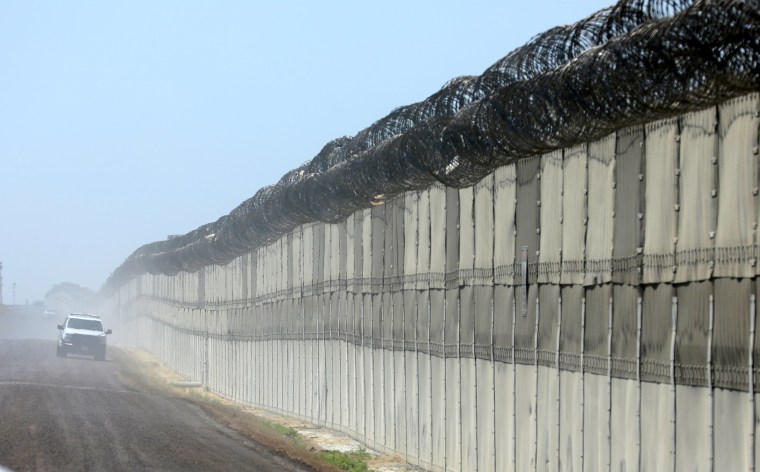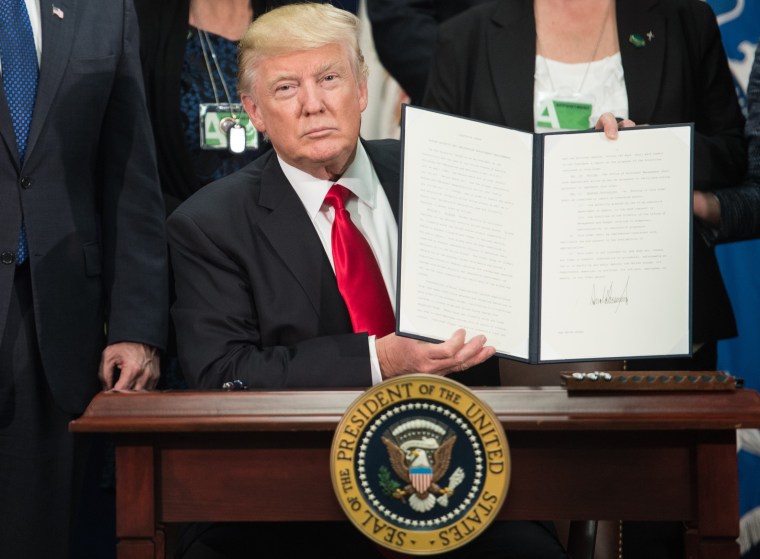During a roundtable meeting with farmers on Tuesday, President Donald Trump remarked that his proposed border wall would help curb human trafficking.
"The wall is going to get built, and the wall is going to stop drugs, and it’s going to stop a lot of people from coming in that shouldn’t be here, and it’s going to have a huge effect on human trafficking, which is a tremendous problem in this world," Trump said.
"A problem that nobody talks about — but it’s a problem that’s probably worse than any time in the history of this world," he added. "Human trafficking, what’s going on."
But experts and even Trump’s own Department of Homeland Security said they are unable to guarantee that the wall would have any impact the rate of trafficking.
"That is a question I’ve been wrestling with," Dottie Laster, executive director of the Heidi Search Center in San Antonio, Texas, and a human trafficking expert, told NBC News. "I’ve been thinking about it daily, and the truth is I don’t know if it will curb it or not."
Laster, who has worked for more than a decade helping victims of human trafficking, said the challenges of getting into the United States is a tool traffickers — sometimes called coyotes — use to their advantage.
She said if the traffickers have trouble getting in to the United States, they could use different paths as leverage over their victims. Conversely, it could also be a potential deterrent.
Related: Flight Attendants Train to Spot Human Trafficking
"It gives them power over someone who’s desperate," Laster said. “I certainly hear of [victims] walking through inhospitable terrain and dying along the way. I think [a wall] might divert that and cause them to go a different route.”

The "Blue Campaign" is the Department of Homeland Security’s program to combat human trafficking and is working to make sure if trafficking victims are taken over the border, they’re rescued or have a resource they can turn to for help.
Blue Campaign fuses the services of U.S. Customs and Border Patrol, U.S. Immigration and Customs Enforcement, and U.S. Citizenship and Immigration Services to fight the problem.
Due to the stealthy nature of human trafficking, however, it is unable to keep reliable metrics on how many victims are taken in or out of the United States.
"Because human trafficking is a hidden crime and victims rarely come forward to seek help because of language barriers, fear of the traffickers, and/or fear of law enforcement, there are often challenges in isolating metrics," Justine Whelan, a spokeswoman for the Department of Homeland Security’s Office of Public Affairs told NBC News in an email.
Whelan said there are currently 42,000 front-line CBP officers and Border Patrol agents protecting nearly 7,000 miles of land border and 328 ports of entry. This includes crossing by land, air and sea.
Related: Human Trafficking in Hotels: New York Lawmaker Teams Up With Advocate
Polaris, one of Blue Campaign’s partners, keeps independent records of calls made to the Línea Nacional Contra la Trata de Personas and Polaris’ National Human Trafficking Resource Center in an attempt to gain data on trafficking at the border.
Between Sept. 30, 2015 and Aug. 31, 2016, 508 human-trafficking victims were reported, according to Polaris’ data.
Of those, the majority of victims were female adults of Mexican nationality.
Most people taken across the border — 49 percent — were trafficked for the purposes of labor trafficking, according to Polaris. Sex trafficking made up another 46 percent.
Polaris’ data also said the majority of traffickers were male adults of Mexican nationality.

But, since the raw data is only a partial picture of the issue, the Department of Homeland Security was unable to comment on whether or not a border wall would notably curb human trafficking through the border.
The White House did not immediately respond to a request for comment about Trump's statements regarding human trafficking.
Laster said she wants people to be aware that traffickers aren’t just bringing people into the United States — they’re also taking people the other direction across the border into Central America.
“Nobody stops you going out. It’s really easy to get into Mexico, but coming back — the security is more difficult,” Laster said.
She said crossing the border is a “walk through hell,” and if Trump’s border wall prevents the “rape and torture” of victims, it’s something she’ll support.
"I don’t doubt [traffickers] are going to find a way [around any wall], but I think it would make it more difficult for them," Laster said. "I’m all for making it more difficult for them."
